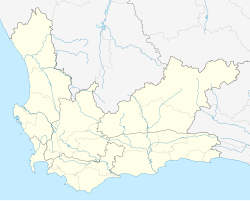Buffels Bay Buffelsbaai | |
|---|---|
Village | |
 Buffelsbaai from the air | |
| Coordinates: 34°05′S22°58′E / 34.083°S 22.967°E | |
| Country | South Africa |
| Province | Western Cape |
| District | Garden Route |
| Municipality | Knysna |
| Ward | 5 |
| Government | |
| • Councillor | Hilton Stroebe |
| Area | |
• Total | 0.82 km2 (0.32 sq mi) |
| Population (2011) [1] | |
• Total | 71 |
| • Density | 87/km2 (220/sq mi) |
| Racial makeup (2011) | |
| • Black African | 1.4% |
| • Coloured | 71.8% |
| • White | 26.8% |
| First languages (2011) | |
| • Afrikaans | 100.0% |
| Time zone | UTC+2 (SAST) |
| Website | www |
Buffelsbaai (also Buffels Bay and Buffalo Bay) is a small seaside village 15 kilometres [2] from Knysna in the Garden Route District Municipality in the Western Cape province of South Africa.
Contents
The village is named after Buffelsbaai which stretches east of the village. It is a popular vacation destination with a small waterfront with stores.



